Inpatient census 2016: parts one and two
Results of the second Mental Health & Learning Disability Inpatient Bed Census and Out of Scotland NHS Placements Census, 2016.
This document is part of a collection
4. Additional Analysis: Patients receiving Forensic Services

Forensic psychiatry is a specialized branch of clinical psychiatry which relates to mentally disordered offenders and others with similar problems. For the purpose of the analysis contained in this section, forensic patients were identified if NHS Boards indicated 'yes' to the following census question: is the patient being managed primarily by forensic services?
There were 458 patients were primarily managed by Forensic Services in the 2016 census.
It should be noted that NHS Greater Glasgow & Clyde, NHS Lothian and NHS Tayside contain Forensics Regional Units which provide services to patients from other NHS Boards. NHS Fife also provide a low secure Learning Disability (Forensic) Regional Unit for the treatment of patients from other NHS boards. The State Hospital (a Special NHS Board), provides a National Service (including for Northern Ireland).
| Number of Patients | ||
|---|---|---|
| NHS Board of Treatment | October 2014 | March 2016 |
| NHS Ayrshire & Arran | * | * |
| NHS Borders | 0 | * |
| NHS Dumfries & Galloway | 0 | * |
| NHS Fife | 31 | 34 |
| NHS Forth Valley | 20 | * |
| NHS Grampian | 42 | 42 |
| NHS Greater Glasgow & Clyde | 128 | 122 |
| NHS Highland | * | * |
| NHS Lanarkshire | 19 | 15 |
| NHS Lothian | 65 | 47 |
| NHS Tayside | 65 | 55 |
| NHS Western Isles | 0 | 0 |
| State Hospital | 121 | 117 |
| Scotland | 507 | 458 |
*suppressed due to small numbers
Age and Gender
The following chart shows that the large majority of patients receiving forensic services are working age males:
Patients receiving Forensic Services, by age and gender, 2016

- 94% (431) of all patients receiving Forensic Servics were male at the census.
- There were 27 female patients receiving Forensic Services. These were all aged between 18 and 64.
- There were 12 males aged 65 and over receiving Forensic Services.
- The age and gender of patients receiving Forensics Services at the 2016 census were similar to the 2014 census.
- There is no specialist 'older adult forensic' or 'older adult learning disability forensic' inpatient provision in Scotland, so those patients whose needs are better met on older adult wards transfer there and then come under the care of older adult services (even if forensic services continue to liaise).
Ward Type
The following chart shows the number of patients receiving Forensic Services by ward type:
Patients receiving Forensic Services, by ward type, 2016
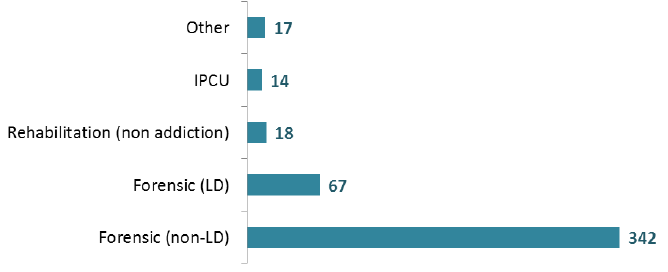
- 89% (409) of patients receiving Forensic Services were in a Forensic ward. 67 of these patients were in a specialist Learning Disability ward.
- 18 patients (3%) were in a rehabillitation (non addiction) ward, while 14 (3%) were in an Intensive Psychiatric Care Unit ( IPCU).
Ward Security Level
The following chart shows the number of patients receiving Forensic Services, by the security level of their ward:
Patients receiving Forensic Services, by ward security level, 2016

- Around one in three patients receiving Forensic Services were in a Low Security ward.
- Almost a third (30%) of forensic patients were treated in a Medium Security ward.
- Just over a quarter (26%) of forensic patients were treated in a High Security ward.
- 4% of Forensic patients were in a General Psychiatric Ward. This compares with 74% of all mental health, addiction or learning disability patients.
Specialty of Consultant
Forensic psychiatry is one of several consultant specialties which oversee the care and treatment of forensic patients.
Patients receiving Forensic Services, by consultant specialty, 2016
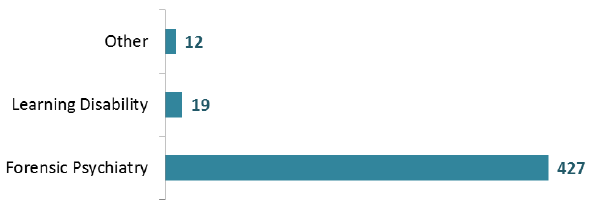
- The vast majority of patients receiving Forensic Services (93%, 427) were seen by a specialist Forensic Psychiatrist.
- 19 patients (4% of all receiving Forensic Services) were seen by a consultant whose specialty was Learning Disabilities.
Length of stay in hospital
There has been little change in the 'days since admission' between the 2014 census and the 2016 census.
Forensic patients, days since admission
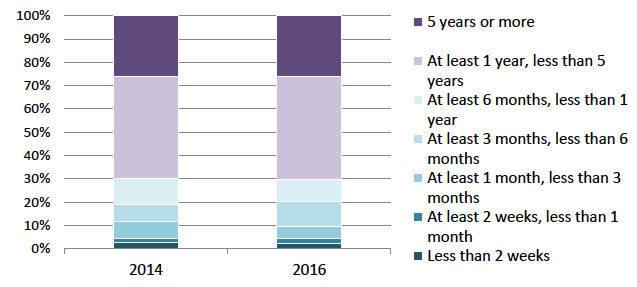
The tables below show that patients receiving Forensic Services, as at the 2016 census, are more likely to stay in hospital for a longer period of time than other mental health, addiction and learning disability patients:
| Days since admission | Patients (March 2016) |
|---|---|
| Less than 2 weeks | 10 |
| At least 2 weeks, less than 1 month | 10 |
| At least 1 month, less than 3 months | 23 |
| At least 3 months, less than 6 months | 49 |
| At least 6 months, less than 1 year | 45 |
| At least 1 year, less than 5 years | 202 |
| 5 years or more | 119 |
| Group | Average (median) number of days since admission | Approx. number of years / months |
|---|---|---|
| Patients receiving Forensic Services | 802 | 2 years, 2 months |
| Other Mental Health, Addiction and Learning Disability patients | 115 | 4 months |
- More than two thirds (321, 70%) of patients receiving Forensic Services had been in hospital for more than a year.
- The average (median) time since admission at the census for patients receiving Forensic Services was just over 2 years.
- Length of stay for patients receiving Forensic Services will be influenced by the fact that around 56% of them are in a Medium Security or a High Security ward.
- This compares with the average time since admission of around 4 months for other mental health, addiction and learning disability patients (i.e. those who don't receive Forensic Services).
Forensic patients on pass
| Was patient on pass at census date? | Patients (March 2016) |
|---|---|
| Yes | 24 |
| No | 434 |
| All forensic patients | 458 |
- 5% of patients being treated under forensic services were on pass as at the census.
- Of the 24 patients on pass, 15 were at home.
Observation level
All patients in mental health inpatient settings will receive some degree of observation. However, levels of observation will vary according to the patients' individual needs. Based on current guidelines the level of observation of patients at the time of the census was recorded. The observation levels are:
- "General Observation" - Staff should have a knowledge of the patients' general whereabouts.
- "Constant Observation" - Staff should be constantly aware of the precise whereabouts of the patient.
- "Special Observation" - Patient should be in sight and within arm's reach of a member of staff.
- Enhanced care plan for therapeutic engagement - Aims to improve observation practice through therapeutic engagement with suicidal, violent or vulnerable patients to prevent them from harming themselves or others at times of high risk during their recovery.
The following chart shows that most patients receiving Forensic Services (93%) fall under the General Observation category.
Patients receiving Forensic Services, by observation level, 2016

Note: Not applicable relates to either patients who are being treated in care homes where an observation level may not apply, or patients on pass.
Health and Wellbeing
The following sections consider the mental and physical health of the forensic patients. The 2016 Census additionally collected some information around lifestyle factors which can impact on a person's health and wellbeing.
Mental health morbidities
The following chart presents the most common diagnosed mental health morbidities, as at the census date, for patients treated under Forensic Services. Note that a patient may have more than one diagnosis.
- The most common diagnosis was Schizophrenia. 301 patients (66%) had a diagnosis of Schizophrenia. This was followed by Personality Disorders with 84 patients (18%) and Learning Disability with 76 patients (17%).
Patients receiving Forensic Services, by most common mental health morbitity, 2016
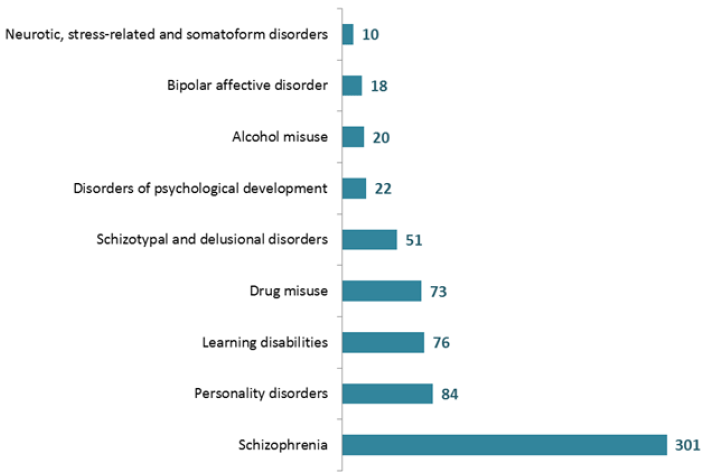
Note: All mental health diagnoses are based on ICD10 codes. Primary and secondary diagnoses included.
Note that a patient may have more than one diagnosis.
Physical health co-morbidities
List of yes/no physical health morbidities questions in the census:
● Hypertension,
● Dyslipidaemia,
● Coronary heart Disease,
● Epilepsy,
● Chronic Kidney Disease,
● Thyroid Disease,
● Cancer,
● Alcohol Acquired Brain Injury,
● Diabetes,
● Chronic Obstructive Pulmonary Disease,
● Chronic Pain,
● Sensory Impairment,
● Liver Dis
● Acquired Brain Injury, ease,
● Stroke / Transient Ischaemic Attack,
● Parkinson
One of the key outcomes from the 2014 Census was the need to improve the recording of both mental health and physical health morbidities. Mental Health and Learning Disability services in NHS Boards are working towards routinely recording physical health conditions under the International Classification of Diseases. As an interim, the 2016 Census included a suite of Yes/No physical health questions. All NHS Boards provided a Yes/No answer for all of their forensics patients.
- 41% of patients had at least one long term physical health co-morbidity based on the suite of Yes/No physical health questions as at the census.
- 20% (93) of all forensics patients had 1 physical health co-morbidities based on the suite of Yes/No physical health questions as at the census, 14% (64) had 2 physical health co-morbidities and 7% (30) had 3 or more physical health co-morbidities.
Forensic patients with long term physical health co mobidities*, 2016

*Physical health co-morbidities are based on responses to a suite of Yes/No physical health questions in the census. Morbidities included: Hypertension, Diabetes, Dyslipidaemia, Chronic Obstructive Pulmonary Disease, Coronary heart Disease, Chronic Pain, Epilepsy, Sensory Impairment, Chronic Kidney Disease, Liver Disease, Thyroid Disease, Acquired Brain Injury, Cancer, Stroke / Transient Ischaemic Attack, Alcohol Acquired Brain Injury, Parkinson.
The following chart illustrates the prevalence of selected physical health morbidities for the forensic patients. Note that a patient can have more than one physical health morbidity.
Patients receiving Forensic Services, by most common physical health condition, 2016*

- 15% of forensic inpatients had Hypertension as at the census date. This was the most common physical health co morbidity from the suite of physical health conditions which were asked specifically about in the census.
- After Hypertension, Diabetes and Dyslipidaemia were the next most prevalent physical health co-morbidities amongst forensic patients with 13% and 12% respectively.
Lifestyle factors
BMI (Body Mass Index)
The following chart shows the BMI (Body Mass Index) distribution for forensic patients. Note the chart excludes a small number of cases where height and weight information was not provided in order to calculate BMI scores.
Patients receiving Forensic Services, BMI Index, 2016
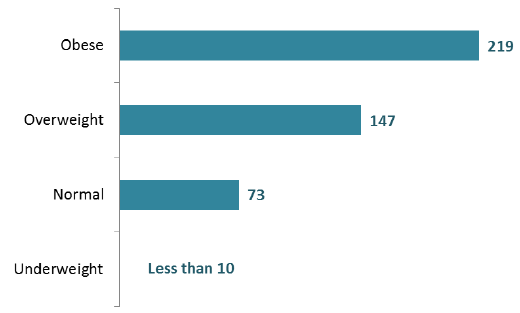
- 83% of forensic patients were either Overweight or Obese as at the census.
- 17% of forensic patients had a Normal BMI score as at the census.
Smoking, alcohol and other substance misuse
The 2016 census included a number of questions around alcohol and other substance misuse. It is known that not all patients with alcohol dependence or substance abuse will have a formal ( ICD10) diagnosis. This section contains analysis of patients with alcohol dependence and / or substance misuse based on responses for a combination of questions (see Section 6 for further detail).
- A third of forensics patients (151, 33%) smoked tobacco in the 12 weeks prior to the census date.
- Around a third of forensics patients (147, 32%) had a dependence on alcohol / harmfully used alcohol. Of these, 20 patients had an alcohol-related diagnosis based on ICD10 codes.
- 42% (192) of forensics patients had abused substances (excluding alcohol). Of these, 73 patients had a diagnosis of drug misuse based on ICD10 codes.
Patients receiving Forensic Services, smoking, drugs and alcohol
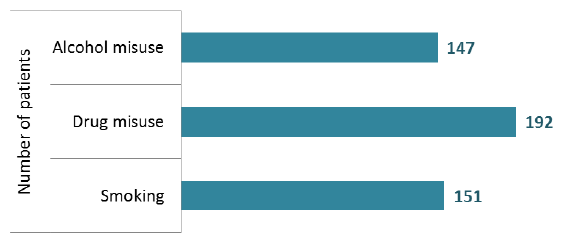
Self harm
This information was provided for 358 out of 458 patients.
- 62 forensics patients self harmed in the week prior to admission to hospital. This is 17% of all forensics patients where this information was known.
- Two thirds (66%, 41) of those who self harmed in the week prior to admission, self harmed by non accidental injury.
Note that patients can be in multiple categories in the following chart.
Patients receiving Forensic Services, by self harm
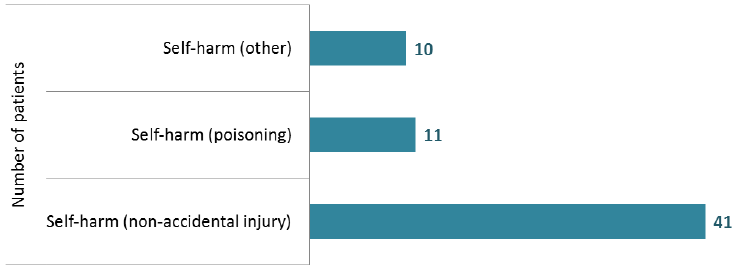
Suicidal ideation
This information was provided for 352 out of 458 patients.
- 23 forensics patients expressed suicidal ideation on admission to hospital. This is 7% of those which information was known for.
In addition to the 458 patients who were primarily managed by the Forensics Services, there were 38 patients who were also primarily managed by Forensics Services and had their care funded by NHS Scotland, but were treated outwith NHS Scotland facilities. See Chapter 5 for further information.
Contact
Email: Steven Gillespie, swstat@gov.scot
There is a problem
Thanks for your feedback